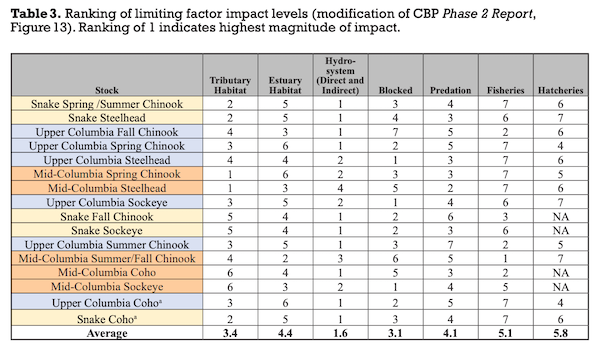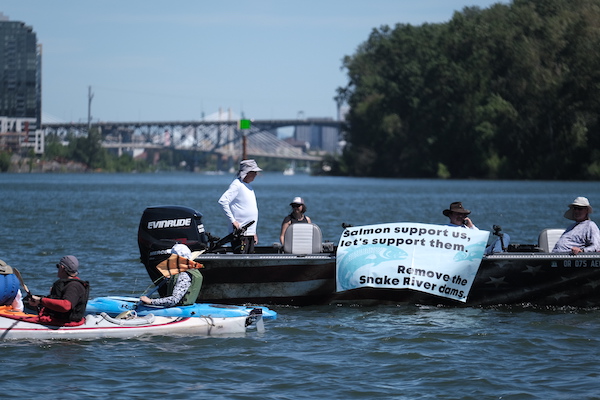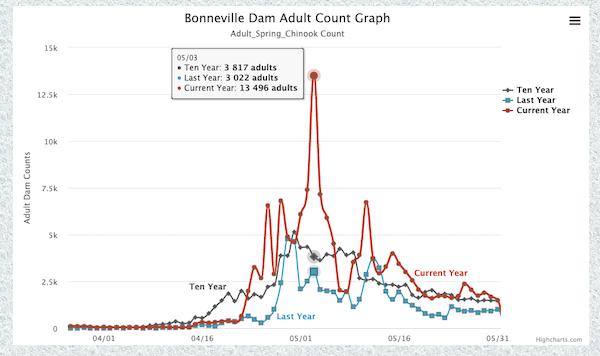
Dam Breaching ‘Essential’ To Restore Snake Runs
“It is not too late to rebuild the vibrant, productive ecosystems on which most fish and wildlife resources, as well as the people of the Columbia River basin, depend.”
So states the final line of a draft federal assessment of what it will take to rebuild the watershed’s salmon and steelhead, with a particularly keen eye focused on breaching the lower four Snake dams, termed “essential” to rebuilding that river’s stocks.

It was released this morning by the National Marine Fisheries Services via the White House Council on Environmental Quality and answers a series of questions, including “Which actions have the highest likelihood of helping” restore the Columbia’s myriad upper basin runs “in the face of climate change?”
At the top of a comprehensive list is, “Significant reductions in direct and indirect mortality from mainstem dams, including restoration of lower Snake River,” while other actions include directed and indirect management of fish-eating predators, tributary and estuary restoration, fish passage into the Upper Columbia and “focused hatchery and harvest reform.”
The report notes that of those, the hydropower system was ranked in 2020 as the highest limiting factor for Snake River spring-summer and fall Chinook, coho, sockeye and steelhead, as well as several Mid- and Upper Columbia stocks, with fisheries and hatcheries on average having the lowest magnitudes of impact, and fish passage, tributary habitat, predation and estuary habitat ranked between them.

“The importance of the comprehensive suite of actions listed above cannot be overstated. It is also important to recognize that, within this suite, several centerpiece actions are paramount for specific stocks … For Snake River stocks, it is essential that the lower Snake River be restored via dam breaching,” the report states.
Along with NMFS and the U.S. Fish and Wildlife Service, contributors included Nez Perce Tribe and State of Oregon fish managers and scientists.
It’s one of two reports released today around the question of breaching. The other, an independent analysis, looks at how much it would cost to replace the four dams’ hydropower and grid systems, with most estimates ranging from $11 billion to $19 billion, but up to $75 billion under Washington and Oregon decarbonization policies.
“Together, the two documents released this morning show the Biden administration is willing to entertain restoration of the lower Snake River to its free-flowing state to give the wild salmon the best chance at recovery and the government its best shot at meeting obligations outlined in treaties with several Columbia Basin Indian tribes,” reports Eric Barker at the Lewiston Tribune. “It’s a move that other administrations have been content to sidestep because of its significant downsides, such as the loss of about 900 megawatts of hydropower annually and the elimination and tug-and-barge transportation between Lewiston and the Tri-Cities.”
“But it’s also an indication that the once-unthinkable idea of dam breaching continues to build slow and steady momentum,” Barker adds.
Indeed, the reports follow on the comprehensive $33.5 billion plan released early last year by Idaho Congressman Mike Simpson (R), a one-year pause in litigation over hydropower operations in federal court, last month’s release by senior Washington Democrats US Senator Patty Murray and Governor Jay Inslee of a draft report on the costs and benefits of removing the earthen portions of the four dams, and recent rallies in support of the effort.

“The federal report specifically identifies the need for breaching the four lower Snake River dams, if we are to have harvestable abundances of salmon and steelhead,” said Liz Hamilton, executive director of the Northwest Sportfishing Industry Association. “This document resolves the science debate surrounding what the salmon need and demonstrates how aligned state, tribal and federal scientists are on the science.”
“Together, we can figure out the how,” Hamilton added. “Thankfully, regional electeds such as Representative Mike Simpson, Senator Patty Murray and Governors Jay Inslee and Kate Brown are sharply focused on the question of how.”
As for the Upper Columbia, blocked by Chief Joseph and Grand Coulee Dams, the NMFS report states that “it is essential to provide passage into blocked areas,” which sounds more like collection and transportation around the two structures for upstream-migrating adults – as is being done now by the Colville Tribes – and ocean-bound smolts.
It also calls for improved dam passage to aid Mid-Columbia stocks, as well as improving habitat and flows to boost the survival of young fish.
Dam removal opponents in Eastern Washington have pointed to increased fish runs in recent years, saying it’s thus “misguided” to talk now about taking out the Snake quartet. Earlier this summer they introduced a bill in Congress to protect the structures built from the 1950s into the 1970s.

Kurt Miller, who heads up the utility- and shipping-oriented Northwest RiverPartners, claimed today’s report “feels more politically motivated than scientific,” according to The Seattle Times. “Unfortunately, we have no confidence in this latest report from NOAA Fisheries,” which he said contradicts other research and findings, reported Linda V. Mapes underneath an article headline of “White House Weighs In On Lower Snake River Dam Breaching In Unusual Power Play.”
NMFS acknowledges that improved ocean conditions are providing a “welcome respite, but are not expected to reverse ongoing trajectories (i.e., the increased frequency, magnitude, duration and scope of environmental downturns) associated with a changing climate. All identified under Question 5 [the actions deemed to have the highest likelihood of helping] need to be implemented as soon as possible.”
Those that would provide “tangible benefits shortly after implementation” and the “most significant survival boost for a broad range of priority populations” appear to be “additional predator controls in the mainstem and expedited restoration of the lower Snake River.”
Since the early 1990s, anglers have been paid to remove northern pikeminnow, numbers of which are “unnaturally high” due to the hydropower reservoirs, though the program has seen waning participation in recent years that has seen managers attempt to counter dropoff with increased rewards and other incentives.
Notably, the federal report appears to stop short of calling for bounties on walleye, bass and channel catfish, though its language around the introduced game fish will still leave their fans bristling.
“Restoring a more natural water velocity and riverine channel morphology in the mainstem reaches of the Columbia and Snake Rivers will dramatically reduce the abundance, distribution and encroachment of undesirable non-native species that thrive in reservoir habitats. Several of these species (walleye, smallmouth bass, and catfish) feed on native juvenile salmon, steelhead, and lamprey. Several other non-native species (carp and American shad) alter the food web and likely compete with native species for food. Native, diverse macro-invertebrate communities will be restored,” NMFS states.
Well away from the river and back in the other Washington, according to the White House Council on Environmental Quality, the Biden Administration “has not endorsed the Columbia Basin Partnership Task Force’s goals at this time or the particular actions identified in today’s draft science report,” but “it is carefully considering this information and ongoing regional efforts as it assesses long-term pathways for the Columbia River basin.”
“Business as usual will not restore the health and abundance of Pacific Northwest salmon. We need a durable, inclusive, and regionally-crafted long-term strategy for the management of the Columbia River Basin,” said CEQ Chair and Columbia River System questions coordinator Brenda Mallory in a press release. “These two reports add to the picture – that we are working alongside regional leaders to develop – of what it will take over the decades ahead to restore salmon populations, honor our commitments to Tribal Nations, deliver clean power, and meet the many needs of stakeholders across the region.”
Stay tuned.

